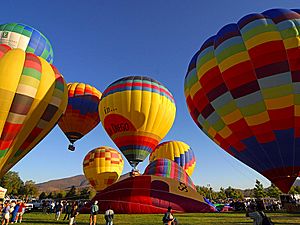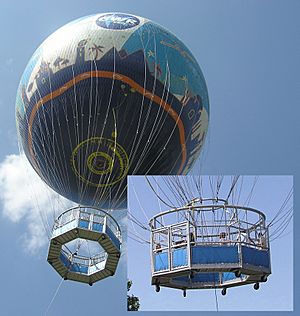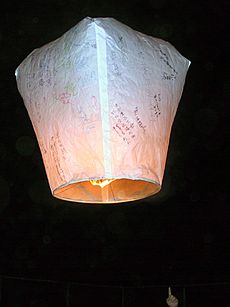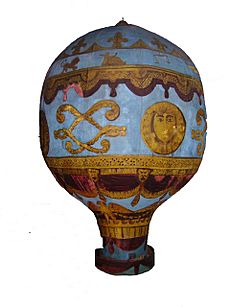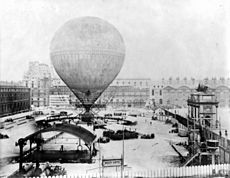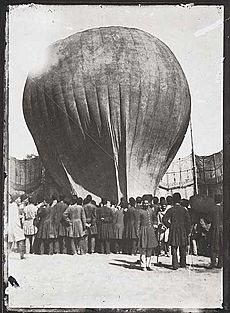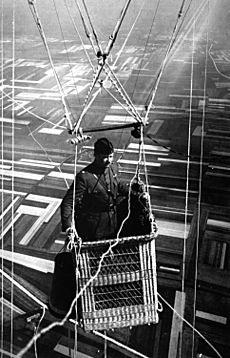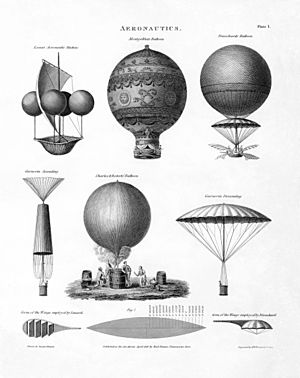Balloon (aeronautics) facts for kids
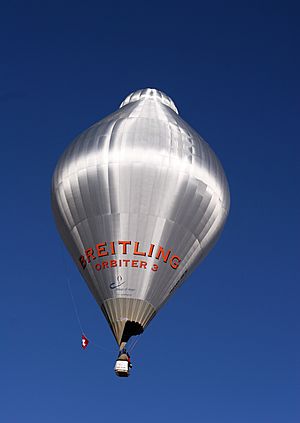
In the world of flying, a balloon is a type of aircraft that doesn't have an engine. It floats in the air because it's filled with a gas that is lighter than the air around it. This is called buoyancy. A balloon can either float freely with the wind or be tied down to a fixed spot. It's different from an airship, which is a powered aircraft that can steer itself.
Many balloons have a basket, a special container called a gondola, or a capsule hanging below. This part carries people or equipment. This equipment can include cameras, telescopes, or controls for the flight.
Contents
How Do Balloons Fly?
A balloon is one of the simplest flying machines. It's basically a large fabric bag filled with a gas that is lighter than the air outside. Because the whole balloon is less dense than the air around it, it rises. It carries a basket or gondola underneath, which holds passengers or other things. Even though balloons don't have engines, pilots can control their direction a little. They do this by making the balloon go higher or lower to find different wind directions.
There are three main kinds of balloons:
- The hot air balloon, also known as a Montgolfière, floats by heating the air inside it. This is the most common type you see today.
- The gas balloon, or Charlière, is filled with a gas that is lighter than the air around it. Most gas balloons have the same pressure inside as the air outside. A special kind, called a superpressure balloon, keeps its gas at a higher pressure. This helps it stay up longer without losing gas. Common gases used include:
- hydrogen – This gas was used a lot in the past. But after the Hindenburg disaster, it's rarely used now because it can catch fire easily.
- coal gas – This gas was popular in the 1800s and early 1900s. It was cheaper and easier to get than hydrogen, even though it didn't lift as much.
- helium – This is the gas used today for almost all airships and most balloons that carry people. It's safe because it doesn't burn.
- The Rozière type uses both heated air and a lighter gas in separate sections. These balloons are sometimes used for very long flights, like flying around the world.
Both hot air balloons and gas balloons are still used today. Hot air balloons are quite affordable. They don't need super strong materials for their outer layer. This makes them popular for fun and sport.
Hot Air Balloons: How They Work
The very first balloon to carry people used hot air to float. It was built by two brothers, Joseph and Etienne Montgolfier, in France in 1783. The first flight with passengers was on September 19, 1783. It carried a sheep, a duck, and a rooster!
The first time a person flew in a balloon that was tied down was on October 15, 1783. The first free flight (not tied down) was on November 21, 1783, using the same Montgolfier balloon.
When air is heated, it expands. This means a certain amount of space holds less air. This makes the air lighter. If the hot air inside the balloon is lighter than the air outside, the balloon will lift off. A hot air balloon can only stay in the air as long as its burner keeps the air inside hot enough.
The Montgolfier brothers' early hot air balloons used a fire pit for heat. This was not as practical as the hydrogen balloons that came soon after. Because of this, hot air ballooning almost disappeared for a while.
In the 1950s, new burners using bottled gas made hot air ballooning easier and cheaper. This led to a big comeback for the sport.
You control the height of a hot air balloon by changing how much the burner heats the air. For gas balloons, pilots often carry weights. They drop these weights if the balloon gets too low. To land a gas balloon, some of the lifting gas must be let out through a valve.
Gas Balloons: Lighter Than Air
Less than a month after the Montgolfier flight, on December 1, 1783, Professor Jacques Charles and the Robert brothers flew a balloon filled with hydrogen. Hydrogen is a very light gas. Gas balloons can lift more weight for their size. They can also stay in the air much longer than hot air balloons. Because of this, gas balloons were the main type of balloon for the next 200 years. In the 1800s, it was common to use town gas to fill balloons. This gas wasn't as light as pure hydrogen, but it was much cheaper and easy to find.
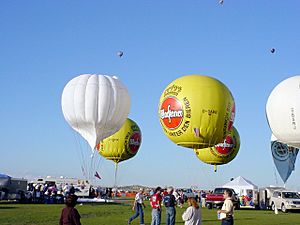
Light gas balloons are often used for science. They can reach very high altitudes and stay up for a long time. They are usually filled with helium. Helium is safe because it doesn't explode, unlike hydrogen when it mixes with oxygen. Most scientific balloon missions don't have people on board.
There are two main kinds of light-gas balloons: zero-pressure and superpressure. Zero-pressure balloons are the traditional type. They are partly filled with gas before launch. The gas pressure inside is the same as the air pressure outside. As a zero-pressure balloon rises, the gas inside expands, and the balloon gets bigger.
At night, the gas in a zero-pressure balloon cools and shrinks. This makes the balloon sink. To stay at a certain height, a zero-pressure balloon has to release gas if it goes too high (to prevent bursting). It releases weights if it sinks too low. Losing gas and weights means these balloons can only stay up for a few days.
A superpressure balloon is different. It has a strong, stretchy outer layer. It's filled with light gas at a higher pressure than the air outside, and then sealed. A superpressure balloon doesn't change much in size. It stays at a constant volume. This type of balloon stays at a steady height in the atmosphere. It can fly for months until gas slowly leaks out.
Superpressure balloons can fly for months, not just days. Often, a mission with a superpressure balloon is ended on purpose. Ground control sends a command to open the balloon and bring it down.
High-altitude balloons are like high-flying ships. They carry scientific tools, like those used in weather balloons. They can also reach almost space-like heights to take pictures or videos of Earth. These balloons can fly over 100,000 feet (30.5 km) high. They are designed to burst at a certain height. Then, a parachute opens to safely bring the equipment back to Earth.
Cluster ballooning is when many smaller gas-filled balloons are used together to lift something.
Combination Balloons: The Best of Both Worlds
Early hot air balloons couldn't stay up for very long because they used a lot of fuel. Early hydrogen balloons were hard to move up or down. Pilots could only let out gas or drop weights a limited number of times. Pilâtre de Rozier realized that for a long flight, like crossing the English Channel, a pilot would need to use different wind directions at different heights. This meant good altitude control was key, while also staying up for a long time. He created a special balloon with two gas bags, called the Rozier balloon. The top bag held hydrogen for steady lift. The bottom bag held hot air, which could be quickly heated or cooled to change the lift and control height.
In 1785, Pilâtre de Rozier tried to fly across the Channel. But soon after takeoff, the hydrogen gas bag caught fire. De Rozier did not survive the accident. He became known as "The First to Fly and the First to Die."
It wasn't until the 1980s that new technology made Rozier-type balloons safe. For example, they started using non-flammable helium as the lifting gas. Several designs have since made successful long-distance flights.
Tied-Down Balloons and Kite Balloons
Instead of flying freely, a balloon can be tied down. This allows it to take off and land in the same spot reliably. Some of the very first balloon flights were tied down for safety. Since then, balloons have been tied down for many reasons. These include military observation, weather tracking, and for fun commercial rides.
A round balloon can be unstable in strong winds. Tied-down balloons used in windy places are often shaped to be more stable. They are also connected to the tether with a special harness. These are called kite balloons.
A kite balloon is different from a kytoon. A kytoon gets some of its lift from the wind, like a kite.
History of Balloons
Early Ideas and Inventions

Unmanned hot air balloons have a long history in China. Zhuge Liang, a leader in the Three Kingdoms era (220–280 AD), used flying lanterns for military signals. These are known as Kongming lanterns. The Mongolian army later learned about these lanterns from the Chinese. They used them in battles, like the Battle of Legnica.
In 1709, a Brazilian-Portuguese priest named Bartolomeu de Gusmão made a small balloon filled with heated air rise inside a room in Lisbon. On August 8, 1709, he successfully lifted a small paper balloon about four meters high in front of the king. He also claimed to have built a larger balloon called Passarola (meaning Big bird). He said he tried to fly himself from a castle in Lisbon and landed about one kilometer away. While there are records of this attempt, the exact details are not fully confirmed.
The First Modern Balloons
After Henry Cavendish studied hydrogen in 1766, Joseph Black suggested that a balloon filled with hydrogen could float in the air.
The first recorded flight with people was in a hot air balloon built by the Montgolfier brothers. This happened on November 21, 1783. The flight began in Paris and went up to about 500 feet. The pilots, Jean-François Pilâtre de Rozier and François Laurent d'Arlandes, flew about 5.5 miles (9 km) in 25 minutes.
On December 1, 1783, Professor Jacques Charles and the Robert brothers made the first gas balloon flight, also from Paris. Their hydrogen-filled balloon flew almost 2,000 feet (600 m) high. It stayed in the air for over 2 hours and traveled 27 miles (43 km). It landed in the small town of Nesles-la-Vallée.
The first balloon flight in Italy was made by Count Paolo Andreani and two others on February 25, 1784. The balloon was designed by the Gerli brothers. A public flight happened a few days later, on March 13, 1784. The balloon flew to a height of 1,537 meters (5,043 ft) and traveled 8 kilometers (5.0 mi).
De Rozier made another flight on June 23, 1784. He used a changed version of the Montgolfiers' first balloon, named La Marie-Antoinette. They took off in front of the King of France. The balloon flew north at about 3,000 meters (9,800 ft), above the clouds. It traveled 52 km (32 mi) in 45 minutes before cold weather made them land.
The first balloon flight in Britain was by James Tytler on August 25, 1784, in Edinburgh, Scotland. It was a hot air balloon.
The first aircraft disaster happened in May 1785. The town of Tullamore, Ireland, was badly damaged when a balloon crashed. The crash caused a fire that burned down about 100 houses. This made Tullamore the site of the world's first aviation disaster. Even today, the town's shield shows a phoenix rising from ashes.
Jean-Pierre Blanchard made the first manned balloon flight in America on January 9, 1793. He had already flown balloons in many European countries. His hydrogen-filled balloon took off from a prison yard in Philadelphia, Pennsylvania. The flight reached 5,800 feet (1,770 m) and landed in Gloucester County, New Jersey. President George Washington watched the takeoff. Sophie Blanchard, Jean-Pierre's wife, was the first woman to pilot her own balloon. She was also the first woman to make ballooning her job.
On September 29, 1804, Abraham Hopman became the first Dutchman to fly a balloon successfully in the Netherlands.
Gas balloons were the most common type from the 1790s until the 1960s. The French military observation balloon L'Intrépide from 1795 is the oldest preserved aircraft in Europe. It is on display in a museum in Vienna. Jules Verne wrote a short story in 1852 about being stuck in a hydrogen balloon.
The first successful balloon flight in Australia was by William Dean in 1858. His gas-filled balloon traveled 30 km (19 mi) with two people.
Henri Giffard also created a tethered balloon for passengers in 1878 in Paris. The first modern tethered balloon was made in France in 1994.
Balloons in the Military
The first time a balloon was used in war was at the Battle of Fleurus in 1794. The French army used L'Entreprenant to watch enemy movements. A special balloon unit was created in the French army in 1794. But it was hard to make hydrogen on the battlefield, so the unit was stopped in 1799.
Balloons were used a lot in the military during the American Civil War. The Union Army Balloon Corps was set up in 1861.
During the Paraguayan War (1864–70), the Brazilian Army used observation balloons.
The British Royal Engineers used balloons in 1885 for scouting and watching during expeditions in Africa. A School of Ballooning was started in Britain in 1888. During the Second Boer War (1899–1902), observation balloons were used. One balloon stayed inflated for 22 days and traveled 165 miles with British forces.
Hydrogen-filled balloons were widely used in World War I (1914–1918). They helped spot enemy troop movements and guide artillery fire. Observers in the balloons would call down reports to officers on the ground. Enemy planes often targeted these balloons. Planes attacking balloons were sometimes given special bullets to set the hydrogen on fire.
The Aeronaut Badge was created by the United States Army in World War I. It was given to soldiers who were skilled balloon pilots. Observation balloons were still used after World War I, including in the Russo-Finnish Wars.
During World War II, the Japanese launched thousands of hydrogen "fire balloons" towards the United States and Canada. The British also used balloons to carry burning materials to Nazi Germany in Operation Outward. In recent years, balloons have been used to carry burning items across borders.
Large helium balloons are used by the South Korean government and private groups. They send messages and supplies across the border to North Korea. A North Korean military official has called this "psychological warfare."
Hot Air Balloons Make a Comeback
Ed Yost redesigned the hot air balloon in the late 1950s. He used strong nylon fabrics and powerful propane burners. This led to the modern hot air balloon we know today. His first flight with this new design was on October 22, 1960. It lasted 25 minutes and covered 3 miles (5 km). Yost's new design started the modern sport of hot air ballooning. Today, hot air balloons are much more common than gas balloons.
In the late 1970s, British balloonist Julian Nott built a hot air balloon. He used materials and methods he thought the ancient Nazca culture of Peru might have had. He showed that it could fly. Nott has wondered if the Nazca people might have used balloons to help design the famous Nazca Lines. Nott also started using hybrid energy for balloons, where solar power helps heat the air. In 1981, he crossed the English Channel using this method.
Balloons Today

In 2012, the Red Bull Stratos balloon carried Felix Baumgartner to 128,100 feet (39,045 m). From there, he made a freefall jump from the stratosphere.
Sports and Fun
Ballooning is a popular sport around the world. Many competitions and festivals are held.
Commercial Uses
Tied-down gas balloons are used as amusement rides in many cities. You can find them in Paris, Berlin, Disneyland Paris, and Walt Disney World. These modern tethered gas balloons are made by a company called Aerophile SAS.
Hot air balloons used for sport are sometimes made in special shapes. Companies use them to advertise their products, like the Chubb fire extinguisher balloon shown in the picture.
Balloons in Space
Balloon Satellites
A balloon in space uses only the gas pressure inside to keep its shape.
The Echo satellite was a balloon satellite launched into Earth orbit in 1960. It was used to bounce radio signals for communication. PAGEOS was launched in 1966. It helped scientists measure locations on Earth more precisely using satellite triangulation.
Planetary Probes
In 1984, the Soviet space probes Vega 1 and Vega 2 released two balloons into the atmosphere of Venus. These balloons carried scientific experiments. They sent signals back to Earth for two days.
Amazing Balloon Records
On October 19, 1910, Alan Hawley and Augustus Post landed in the wild parts of Quebec, Canada. They had traveled for 48 hours and 1887.6 kilometers (1,173 mi) from St. Louis. This was during the Gordon Bennett International Balloon Race. They set a distance record that lasted over 20 years. It took them a week to hike out of the woods. Search parties had been looking for them, thinking they were lost.
From December 13 to 17, 1913, Hugo Kaulen stayed in the air for 87 hours. His record stood until 1976.
On May 27, 1931, Auguste Piccard and Paul Kipfer were the first people to reach the stratosphere in a balloon.
On August 31, 1933, Alexander Dahl took the first picture showing the Earth's curve from an open hydrogen gas balloon.
The helium-filled Explorer II balloon set a new height record. Piloted by US Army Air Corps officers, it reached 22,066 m (72,395 ft) on November 11, 1935. This came after a dangerous flight in July 1934, where their earlier balloon, Explorer, almost crashed.
In 1976, Ed Yost set 13 world records for distance and time in the air. He tried to cross the Atlantic Ocean alone by balloon. He flew 3,938 km (2,447 mi) for 107 hours and 37 minutes.
In 1978, Ben Abruzzo and his team were the first to cross the Pacific Ocean in a hot air balloon.
The highest a manned balloon has ever flown was 34,668 m (113,739 ft). This record was set on May 4, 1961, by Malcolm Ross and Victor Prather. They launched the Strato-Lab V balloon from a ship in the Gulf of Mexico.
The previous record for a manned balloon was 38,960.5 m (127,823 ft). This was set by Felix Baumgartner in the Red Bull Stratos balloon on October 14, 2012. He launched from Roswell, New Mexico.
The current record for a manned balloon is 41,419.0 m (135,889.108 ft). This was set by Alan Eustace on October 24, 2014.
On March 1, 1999, Bertrand Piccard and Brian Jones started their journey in the Breitling Orbiter 3 balloon. They took off from Switzerland for the first non-stop balloon flight around the world. They landed in Egypt after flying 40,814 km (25,361 mi). The flight lasted 19 days, 21 hours, and 55 minutes.
The highest an unmanned balloon has ever flown is 53.0 kilometers (173,882 ft). This was in the mesosphere. The balloon was launched by JAXA from Japan on May 25, 2002. This is the highest an atmospheric vehicle has ever reached. Only rockets and rocket planes have flown higher.
In 2015, two pilots, Leonid Tiukhtyaev and Troy Bradley, landed safely in Baja California, Mexico. They had traveled 10,711 km (6,656 mi). The two men, from Russia and the United States, started in Japan. They flew a helium balloon called "Two Eagles" across the Pacific Ocean. In 160 hours, they set new distance and duration records for gas balloons.
Images for kids
See also
 In Spanish: Globo aerostático para niños
In Spanish: Globo aerostático para niños
- Aerostat
- Balloon release
- Balloon-carried light effect
- Blimp
- Ceiling balloon
- Early flying machines
- Hopper balloon
- Lane hydrogen producer
- Flight altitude record
- List of balloonists
- List of civil aviation authorities
- List of firsts in aviation
- List of inflatable manufactured goods
- Project Manhigh
- QinetiQ 1
- Research balloon
- Skyhook balloon
- Tethered balloon
- Thermal airship
- Virgin Balloon Flights
- Zeppelin



